Archived Blog Posts
Mold Cleaning: Understanding the Standards for Effective Mold Remediation
5/25/2023 (Permalink)
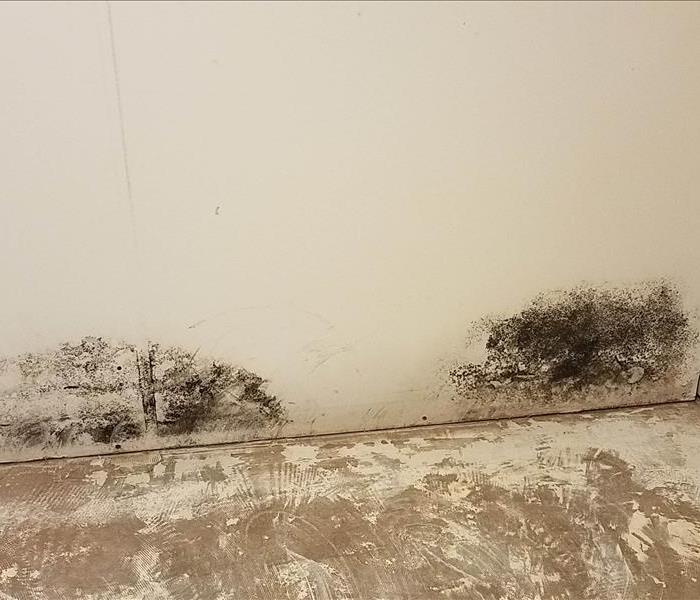 Mold cleanup can be risky, use recommended standard for effective mold remediation.
Mold cleanup can be risky, use recommended standard for effective mold remediation.
Mold growth in homes, offices, and other indoor spaces can pose serious health risks and cause structural damage. Therefore, mold remediation and cleaning are crucial to maintain a healthy indoor environment. But is there a standard for mold cleaning? In this blog, we will explore the concept of mold cleaning standards and their importance in ensuring effective mold remediation.
Standards and Guidelines
Mold cleaning standards are guidelines and protocols that outline the proper methods and procedures for removing mold contamination from indoor environments. These standards are developed and maintained by reputable organizations and agencies, such as the Environmental Protection Agency (EPA), the Occupational Safety and Health Administration (OSHA), the Institute of Inspection, Cleaning, and Restoration Certification (IICRC), and the American National Standards Institute (ANSI). These organizations set the bar for best practices in mold remediation and cleaning, taking into account the latest research, scientific data, and industry expertise.
EPA
One of the most widely recognized and referenced standards for mold cleaning is the EPA's "Mold Remediation in Schools and Commercial Buildings" document, also known as the EPA Mold Remediation Guidelines. This comprehensive guide provides detailed instructions on how to clean up mold contamination in various types of buildings, including schools and commercial properties. It covers topics such as identifying mold, evaluating the extent of mold contamination, protecting workers and occupants during mold cleanup, and proper disposal of moldy materials.
OSHA
OSHA also provides guidelines for mold remediation in the workplace, specifically in construction and general industry settings. These guidelines, outlined in the OSHA Technical Manual, emphasize the importance of assessing and controlling mold exposure to protect workers' health and safety. They cover topics such as respiratory protection, personal protective equipment (PPE), engineering controls, and work practices to prevent the spread of mold during cleanup.
IICRC
The IICRC, a leading organization in the field of inspection, cleaning, and restoration, has also developed the "S520 Standard and Reference Guide for Professional Mold Remediation." This standard provides comprehensive information on mold identification, evaluation, and remediation, as well as guidelines for equipment, containment, and cleaning procedures. The S520 standard is widely used by mold remediation professionals as a reference for best practices.
In addition to these organizations, ANSI has also developed standards related to mold remediation. ANSI/IICRC S500: "Standard and Reference Guide for Professional Water Damage Restoration" includes information on mold remediation as part of the overall water damage restoration process. ANSI/RIA (Restoration Industry Association) 7001: "Standard for Professional Mold Remediation" guides the proper procedures and requirements for mold remediation projects.
It's important to note that mold cleaning standards are not legally binding regulations, but they are widely recognized and followed by industry professionals as the best practices for mold remediation. Adhering to these standards can ensure that mold cleanup is done effectively and safely, protecting the health and well-being of occupants and workers.
In conclusion, while there may not be a single universally recognized standard for mold cleaning, there are widely accepted guidelines and protocols developed by reputable organizations that serve as the industry's best practices. These standards provide valuable guidance on how to effectively and safely remediate mold contamination in indoor environments. If you encounter mold in your home or workplace, it's essential to engage qualified mold remediation professionals who follow these standards to ensure that the mold is properly addressed and removed. DIY mold cleanup is not recommended as it can be risky and may not meet the standards for effective mold remediation.
The Importance of Furnace Maintenance: Saving Money and Extending the Life of Your Heating System
4/12/2023 (Permalink)
A properly maintained furnace will use less fuel and therefore, save you money on your energy bill.
Prolong the Life of Your Furnace
A well-maintained furnace will last longer than one that is not maintained regularly. This means less repairs and breakdowns which can be costly for homeowners in terms of time lost from work, money spent on repairs and replacement parts, as well as inconvenience caused by being without heat during cold weather months when most people rely heavily on their furnaces for heat throughout their homes.
Reduce Risk of Breakdowns and Repairs: By keeping up with regular maintenance appointments at least once per year (or more often if needed), it's possible to prevent future problems before they happen!
When Should I Schedule Furnace Maintenance?
A professional technician will come out once a year to inspect your system and make sure it's in good working order. This is an important step in keeping your home comfortable during the winter months, as well as extending the life of your heating system.
If possible, schedule an annual visit with your HVAC company before or shortly after Thanksgiving so that they can identify any problems before they become serious issues. You'll want them to check for leaks and other issues that could cause harm if left untreated until springtime rolls around again!
If you've been using your furnace more than usual (perhaps due to unusually cold weather), consider scheduling another appointment just after winter ends so that everything can be checked over thoroughly by professionals who know what they're doing before summer hits again next year!
What Should I Expect During a Maintenance Appointment?
During a maintenance appointment, your technician will perform an inspection of the heat exchanger and blower components. They will also clean out any debris from around these parts as well as adjust the burner assembly and pilot assembly.
What Kind of Maintenance Can I Do Myself?
- Change the Filter
- Clean the Registers and Vents
- Inspect the Air Ducts
What Are the Benefits of Professional Maintenance?
The benefits of professional maintenance are numerous. First and foremost, it's an expert diagnosis and repair. If there is a problem with your furnace, our technicians will be able to identify it quickly and accurately so that they can get your system back up and running as soon as possible.
Second, we provide professional cleaning and adjustment services that allow us to clean out any dust or debris that may have accumulated inside the system over time (this includes removing lint buildup in ductwork).
Thirdly, we conduct a comprehensive check of all components within your entire heating system during each visit--from checking wiring connections to inspecting fans for wear--ensuring everything is working properly before leaving so you don't have any surprises later on down the road!
What Should I Look for When Choosing a Professional?
When you're looking for a professional to service your furnace, there are a few things to consider. First and foremost, experience is key. You want someone who has been in the business for a while and knows what they're doing.
5 Essential Tips for Maintaining Fire Sprinklers in Your Building
3/12/2023 (Permalink)
Fire sprinklers are an essential component of any building's fire protection system, and their maintenance is critical to ensure their functionality in the event of a fire. Proper maintenance of fire sprinklers can also help to minimize damage and loss of property in the event of a fire. Here are some tips on how to maintain fire sprinklers in your building.
Regular Inspection
Regular inspections of fire sprinkler systems are important to identify any issues or potential problems. Inspection should be done annually by a licensed professional who can assess the overall condition of the system and check for any leaks or corrosion. They should also ensure that the system is in compliance with local and state regulations and that all components are functioning correctly.
Check Water Supply
The water supply is crucial to the functioning of a fire sprinkler system. Therefore, it is essential to ensure that the water supply is available and is sufficient in the event of a fire. Inspect the water supply valve regularly to make sure that it is open and that the water pressure is within the required range. Also, make sure that the water supply is not compromised by any potential issues like leaks or damage to the piping.
Keep Sprinklers Clean
The sprinkler heads should be kept clean and free from any debris or dirt that can prevent them from functioning properly. Regular cleaning of the sprinkler heads is important to ensure that they are ready to activate in the event of a fire. It is recommended to use a soft brush or cloth to clean the sprinkler heads and avoid using abrasive materials that can damage them.
Test the System
Testing the fire sprinkler system is essential to ensure that it is working correctly. The system should be tested at least once a year to verify its functionality. Testing should be done by a licensed professional who can check the system's response time and coverage area. They can also check the alarm system that is connected to the sprinkler system.
Maintain Documentation
Maintaining proper documentation of the fire sprinkler system is important to ensure that it is in compliance with local and state regulations. It is recommended to keep records of all inspections, tests, and maintenance performed on the system. This documentation can help in case of any legal issues or insurance claims that may arise in the future.
In conclusion, maintaining fire sprinklers in a building is crucial for the safety of the occupants and the property. Regular inspection, checking the water supply, keeping sprinklers clean, testing the system, and maintaining documentation are some of the critical steps in ensuring the system's functionality. It is recommended to hire a licensed professional to carry out these tasks to ensure that they are done correctly and in compliance with local and state regulations.
Kitchen Fire Hazards
2/11/2023 (Permalink)
A kitchen fire can be dangerous and even deadly. Fire start in the kitchen. Most of these fires are small and only cause damage to the kitchen itself, but some result in injuries or deaths.
Overloaded electrical sockets.
Overloaded electrical sockets can cause fires, especially if you use too many appliances in one place. Use only the number of plugs that are required for the number of items being used and don't overload outlets with extension cords. Never use an outlet that has a loose plug or broken cord.
Fire extinguisher.
Fire extinguishers are essential to have in your kitchen. They are an easy and quick way to put out small fires, like grease fires and electrical malfunctions. Fire extinguishers should be placed in a location that is easy to access and can be used by anyone in the kitchen at any time of day or night.
Fire extinguishers should be inspected regularly and replaced when necessary, especially if they have been dropped or exposed to heat sources such as stoves or ovens (which may have melted some of the plastic parts inside).
Cooking when tired.
When you're tired, it's not just your body that suffers. Your judgment is impaired as well. This can lead to accidents such as forgetting to turn off the stove or leaving a pot on it when you leave the room for any reason. It can also cause mistakes in cooking--like adding too much salt or sugar because you weren't paying attention due to your fatigue--that might not be noticed until after dinner is served.
Cooking on the stove.
You should never leave the kitchen while there is something cooking on the stove, in a microwave, or in an oven. You also need to be careful when using slow cookers because they can become extremely hot and cause burns if you're not careful when handling them.
If you must leave your home during these periods of time where food is being cooked--and we all know how hard it can be sometimes!--then make sure that someone else is present who can watch over all of your meals until they've finished cooking.
Using Plastic.
Plastic can melt and catch fire when it is too close to a heat source, such as on top of the stove or near a toaster oven. The heat can cause the plastic to melt or even catch fire. In addition, if you use plastic wrap around hot foods and then put them in the microwave, there's an increased chance of overheating and burning yourself because you're using both methods at once.
Kitchen fires are serious. Kitchen fires can be prevented by taking simple precautions, such as keeping your kitchen clean and dry, storing flammable materials away from the stovetop and oven, keeping pot handles turned inward to prevent them from getting knocked over onto a burner or heating element. Use vent hoods when cooking with oil or grease and turning off the stove when you leave the room. Give SERVPRO of North East Chester County a call for your fire damage emergency.
The Basics of Smoke Damage
1/24/2023 (Permalink)
A fire or smoke damage claim is one of the worst things that can happen to you and your property. This isn’t just about losing your belongings and having to spend money repairing or replacing them; it is also about the emotional impact on you. The truth is that most standard policies cover fire and smoke damage without special add-ons; however, there are exceptions depending on your circumstances.
Smoke Damage Basics
When you think of smoke damage, you probably imagine charred walls, blackened appliances and furniture, and other obvious signs of a fire. But not all instances of smoke damage are so easy to spot. The smell of smoke can linger in your home long after an actual fire has been put out. This can be caused by burning embers left behind when a cigarette is put out on the carpet or other material, or even just from cooking with grease.
Preventing Smoke Damage
It can be difficult to completely eliminate the chances of a fire breaking out on your property. It is important to keep a fire extinguisher on hand. Another tip is to have at least one working smoke alarm in every bedroom and outside each sleeping area. Make sure you have an escape plan for each level of your Spring City, PA home as well. Make sure your smoke alarm is in good working order by testing them every 6 months.
Insurance Coverage after Smoke Damage
The best way to get your insurance claim paid for smoke and fire damage is to hire a professional cleaning company. They will know what products to use and how much of each product should be used, as well as how long they should leave the cleaners on your property.
If you have been in an accident or experienced a natural disaster, it’s important that you report any damage right away. Your insurance company needs this information in order to accurately assess how much money they need to pay out for your claim. This will help them process claims faster and make sure that their customers receive financial compensation for their losses as soon as possible!
Home Value
If you're thinking about selling your home, it's important to know that your property's value may be affected by fire and smoke damage. If you do have a fire in your Spring City, PA home and the smoke has caused damage, you should get an inspection as soon as possible—the sooner the better. A professional home inspection will help determine what repairs need to be made before selling or listing your house for sale. You can't get a loan without having a home inspection done on any property where there is significant visible damage—and neither can anyone else who wants to buy from you!
Smoke damage can be a major problem for homeowners. If you have smoke damage and need help restoring your home back to normal, give SERVPRO of North East Chester County a call.
What is Water Extraction?
12/4/2022 (Permalink)
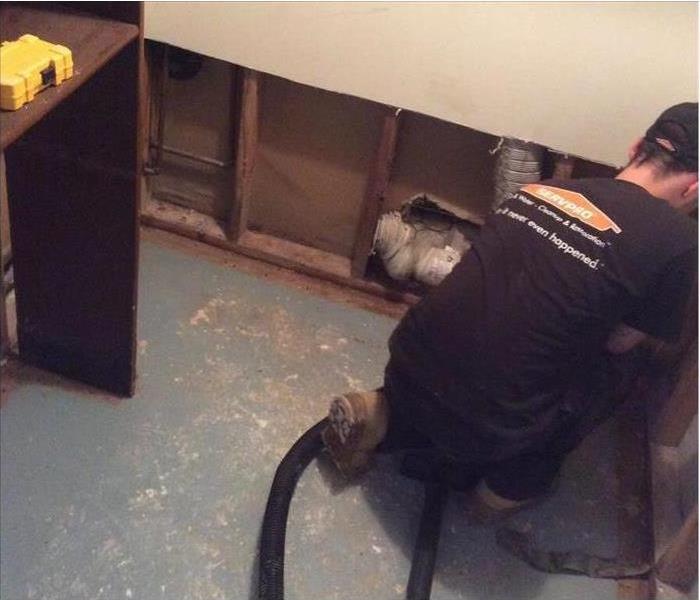 If you do ever find yourself in need of water extraction services, we encourage you to contact SERVPRO of Northeast Chester County
If you do ever find yourself in need of water extraction services, we encourage you to contact SERVPRO of Northeast Chester County
What is Water Extraction?
Water damage can happen to anyone, at any time. There are many reasons why flooding happens, but most of them are out of our control. Rainfall, plumbing problems, leaking or burst pipes, and sewage backup are the most common causes of water damage. Water extraction is necessary in order to prevent future damage from happening when the original water damage has already occurred. Water extraction ensures that no water is left behind within your property by using specialized equipment and techniques to eliminate all traces of moisture completely from your Spring City, PA home or business.
Flood and water damage can happen to anyone at any time.
You may be surprised to learn that water damage can happen to anyone at any time. It's not just a problem for people who live in areas where hurricanes and tornadoes are common—water damage is a real issue everywhere, and it can occur for a wide range of reasons.
Water damage is often caused by storms or other natural disasters. But even if you don't live in an area prone to flooding, there are still plenty of ways that your home could get damaged by water: a burst pipe or faulty plumbing system, an overflowing toilet, faulty construction or roofing materials that leak, clogged gutters allowing rainwater runoff into your basement—the list goes on and on. And while these issues aren't tied exclusively to any one geographic location, those living in areas where precipitation tends to be more intense tend to face more problems from this type of thing than those who don't have such rainy weather patterns year-round.
The reasons for water damage are many and varied. But what if you find yourself in this situation? How do you handle it? What steps should you take?
There are many reasons why flooding happens, but most of them are out of our control.
While there isn't much that can be done about natural disasters like hurricanes and tornadoes, some water damage is preventable if you're aware of your surroundings. It's important to know where your main shutoff valve is located so you can turn off any leaks as soon as they occur. It's also crucial that homeowners locate their main water shutoff valve because this allows them to stop water flow before it gets into their home or business through a busted pipe or leaky sprinkler system.
Extraction ensures that no water is left behind within your property.
Water extraction is a process that ensures no water is left behind within your property. Water damage restoration professionals use powerful, specialized equipment to remove excess moisture from your home or business. This process is necessary for several reasons:
- To prevent future damage
- For safety reasons (e.g., electrical)
- To help with the drying process
Water extraction is necessary in order to prevent future damage.
It's important to understand that water extraction is necessary to keep your home safe in the event of a flood. Water removal is the first step in the restoration process because it prevents mold growth and other damage from occurring. After all, if there is standing water left behind after a flood or leak, you may end up with expensive repairs that don't need to be done if the water was removed initially.
The next step would be drying out any remaining moisture, which can cause mold growth if left untreated. Moisture-free air has a relative humidity level (RH) of less than 50%. To achieve this RH level, dehumidifiers are used as well as fans which circulate air throughout your house so they can dry out areas where moist conditions were present before restoration occurred
We hope that this article has helped you understand why water extraction is necessary and how it can help prevent future damage. If you do ever find yourself in need of water extraction services, we encourage you to contact SERVPRO of Northeast Chester County as soon as possible so that we can assist in any way we can.
Category Three Water Loss
11/1/2022 (Permalink)
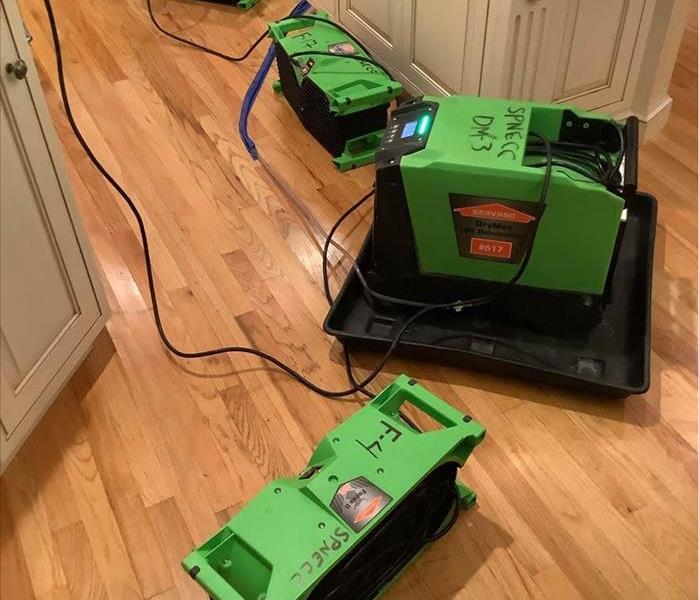 If you have a category three water in your North East Chester County home or business and don't know what to do, call your local SERVPRO®.
If you have a category three water in your North East Chester County home or business and don't know what to do, call your local SERVPRO®.
Category Three Water Loss
Water damage can occur in any home, whether it's a small leak or a major flood. There are three levels of water damage: category one, category two, and category three. Each of these needs to be cleaned up in a particular way. In this blog post, we want to highlight everything you need to know about category three water loss.
What is a Category Three Water Loss?
Category three water damage is commonly referred to as black water because it contains more than just clear water. Sewage is also considered a category three water damage because it contains bacteria that need to be cleaned up by an expert for the home to be safe again.
Black water is a mix of sewage and stormwater that has contaminated your property after the flooding subsided. Black water contains bacteria, viruses, and other contaminants that can cause illness.
Sewage backup can be caused by many different things including aged or damaged pipes; blocked drains; leaks in the sewer line outside your home; blockages caused by tree roots or grease buildup behind your toilet bowl; or even sink overflows from clogged pipes causing overflow into other areas of your home.
Outside Source
It's important to know the difference between black water and gray water. While both are types of water damage, they come from different sources and require different treatments.
Black water comes from an outside source, like a pipe or septic system that has been damaged. If you see black or brown liquid in your home, it could be caused by floods or heavy rains that flood the basement or foundation of your house. Black water often contains sewage and can be contaminated with bacteria.
Dangerous to Health
Blackwater (sewage particularly) can be very toxic and dangerous to your health. It should be cleaned up by professionals in protective gear immediately because it will cause severe health problems if inhaled or ingested.
Call the Professionals
For category three water damage, it's a good idea to call in the professionals. Why? Well, for starters, you have bacteria and mold that need to be cleaned up by an expert. If you try to clean this up on your own, you could make matters worse for yourself or even put others in danger of getting sick.
It's also important that a professional company does its job right because it knows how to avoid damaging any property that wasn't directly affected by the leak itself. For instance, if your carpet was wet but not soaked through with water then it may still look fine after drying out—but if someone tries to shampoo your carpets without being careful they could end up ruining them permanently!
When you suffer from category three water damage, you have to be aware of the risks associated with the mold that grows in your home.
Category three water damage is one of the most dangerous and requires professional attention. If you have a category three water problem in your North East Chester County home or business and don't know what to do, call SERVPRO of North East Chester County today!
How to Prepare Your Business for a Fire.
9/6/2022 (Permalink)
How to Prepare Your Company for a Fire
A fire in your business can be devastating. There are many ways to minimize the damage and losses, but it is important to have a plan in place before a fire occurs.
Make Sure You are Insured
If your business is housed in a building, make sure it’s properly insured and that the coverage is up to date. Most buildings come with fire insurance as part of their mortgage payment, but this might not be sufficient for your needs. Make sure that you have enough protection to cover any damage caused by fires or other disasters. You should also keep up with changes in technology and industry standards as these could affect what kinds of services or products your business provides, which could change how much risk there is associated with them.
Develop an Evacuation and Emergency Action Plan for the Entire Business
The plan should include:
- a fire escape route for all employees to follow if there is a fire, including the safest way out of the building, what to do in an emergency, and where to meet after exiting the building.
- information on how to assist disabled employees or other people who may need help.
- plans for pets that may be left behind during an evacuation. This includes identifying where they will go while you are away from work, keeping them contained in certain areas of your business (such as inside cages) with food and water until you return home from work yourself, or having arrangements made with someone else outside of your business who can care for them while you are gone (a friend/family member).
Keep Your Building in Good Repair
Ensure that all exits are clear and unobstructed. Fire extinguishers should be readily available in areas where they are needed, such as near the kitchen and office area. All fire extinguishers should be inspected regularly to ensure that they are still working properly (they should be replaced every five years). Installing smoke alarms and carbon monoxide detectors is also a good idea, as it will give you more time to evacuate your building if there is a fire. Be sure to have an emergency exit plan for everyone who works at the business!
Keep a fire blanket on hand just in case something does happen!
Store Flammable Liquids Away from Ignition Sources.
Close the lid on containers that contain flammable liquids and place them in a safe location where they will be secure from fire. Do not store flammable liquids near things that can ignite, such as lint or paper, because even minor sparks can ignite these substances. If you see heavy smoke coming from an area where you keep your flammable liquids, evacuate immediately. You may think that putting out the fire is easy but it could cost you your life if you get too close to it. Call 911 right away if there are flames or smoke coming out of any area of your building.
Use a fire extinguisher on small fires only when they start off as burning embers or sparks rather than flames so they won't spread quickly across large areas within seconds which would make them harder for other people who might not have experience using one before trying doing so themselves without knowing how else those types work properly; although there's always room for improvement here too since these situations tend not necessarily happen every time.
Keep Electrical Equipment in Good Working Order, Including Wiring and Outlets
Wiring should be regularly inspected for any signs of damage, such as loose connections or frayed insulation. If you have concerns about the safety of your wiring, contact a professional electrician to inspect it before using it again.
Outlets should be tested regularly with a non-contact voltage tester to ensure that no electrical current is leaking through them (a sign that they may have been damaged).
Being Prepared Can Significantly Reduce Damage if a Fire Occurs
If you're not sure where to start, here are some tips:
- Make sure you have the correct type and number of fire extinguishers for the building. In most cases, this will be either ABC or BC dry chemical extinguishers. You should also have a wet pipe or sprinkler system installed in your building.
- Leave detailed evacuation plans with your employees and make sure they know how to use them in case of emergency. The plan should include an exit map that shows all possible exits from every room in the building as well as any obstacles they may encounter on their way out, such as stairwells blocked by smoke or heat-related hazards like hot surfaces that could burn if touched; broken glass windows; inner doors with warped frames which cannot be opened by hand due to excessive heat buildup inside; etc.
Preparing your business for a fire can be a daunting task, but it doesn’t have to be. If you follow the steps above and make sure that your business is well prepared, you will decrease the risk of damage or injuries in case of an emergency.
Can Lightning Cause a House Fire?
8/26/2022 (Permalink)
Most homeowners experience a number of severe storms each year. Although most people do not usually think about it, a lightning fire can and does occasionally occur. During 2007-2011, lightning-caused over $450 million in property damage each year. Knowing how lightning travels can help you understand your risk of a fire.
What Happens to the House?
All homes contain paths that could be used as the lightning strike travels to different parts of the residence. When a house sustains a direct impact, many types of damage can occur:
- Breaks and cracks in concrete, bricks, and stone
- Shattered windows
- Damaged foundations
- Electrical surges that damage appliances and electronics
- Fire ignition
Once a house is struck, the energy can continue to surge through a path until it reaches the ground. As the energy encounters flammable materials, it can start a house fire. Attics, roofs, and fallen trees are common areas for fires to start.
How Can the Home Be Protected?
Ensure that your house is fitted with a lightning rod and that the rod is the highest point of your dwelling. If the rod is struck, it should allow the electricity to disperse safely through your home and avoid a lightning fire. Keeping your roof in good repair and choosing flame-resistant shingles can help. If tall branches are growing near, consider having them trimmed so that they are not hanging over your roof. Protect your appliances and electronics by using a surge protector or unplugging them during a storm. If your home is struck by lightning, call your emergency fire department to check for fires in areas that may not be obvious.
A lightning fire is a common occurrence in nature but can also occur to homes and other buildings. If you have experienced a fire in Birchrunville, PA, call a professional fire restoration service to help return your home to its pre-fire condition.
3 Ways Fire and Water Damage Can Coincide
8/21/2022 (Permalink)
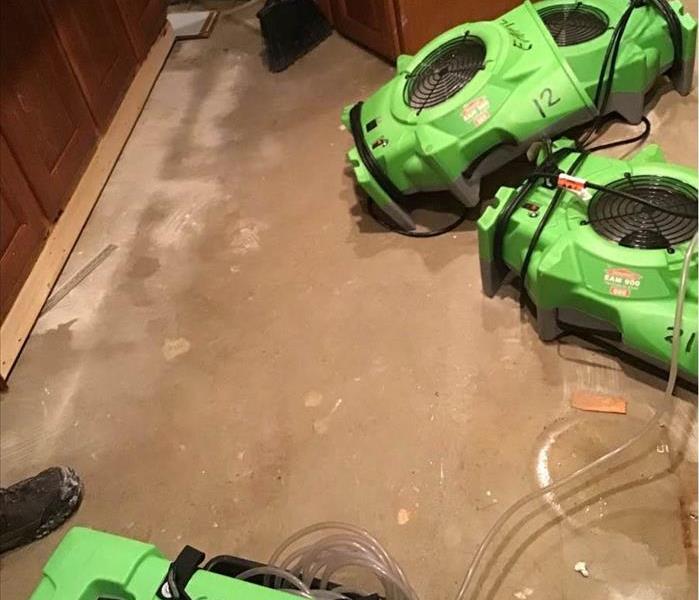 Flames have the most obvious cosmetic and structural effect on a residential property, but damage due to water is often also present.
Flames have the most obvious cosmetic and structural effect on a residential property, but damage due to water is often also present.
Putting out a blaze is the primary concern when firefighters arrive at the scene of a house fire in Phoenixville, PA. Flames have the most obvious cosmetic and structural effect on a residential property, but damage due to water is often also present. Standing water or high levels of residual moisture will compound primary fire damage.
Here Are 3 Ways In Which Water Damage Coincides With Fires
1. Fire Hoses
Hoses that connect to fire hydrants may release anywhere from 60 to 200 gallons per minute. A standard fire hose emits about 150 gallons of water per minute. This can quickly cause standing water to pool in a structure where a conflagration is in the process of being put out. This water starts clean but becomes contaminated by ash and smoke. It may be necessary to pump standing water out of a residence after the Fire Department responds to an incident.
2. Home Fire Sprinklers
Fire sprinklers are designed to activate one at a time to limit the amount of damage due to fire suppression. High air temperatures cause glass bulbs to burst and activate spray mechanisms. These systems can still contribute moisture to fire damage that exacerbates the primary damage.
3. Secondary Damage
When a fire is the original cause of damage to a residence, burnt materials are considered primary damage. Any water introduced to a structure during suppression efforts and the combined effect of fire and water damage are considered secondary damage but should be covered by homeowners insurance in the event of an accidental fire.
No matter the source of water, the clean Category One water emitted by a fire hose or home sprinkler system degrades into grossly contaminated Category Three water upon contact with soot and smoke. Timely mitigation is essential for contaminated water and fire damage at a home located in Phoenixville, PA.
Keep Sneaky HVAC Mold at Bay
8/11/2022 (Permalink)
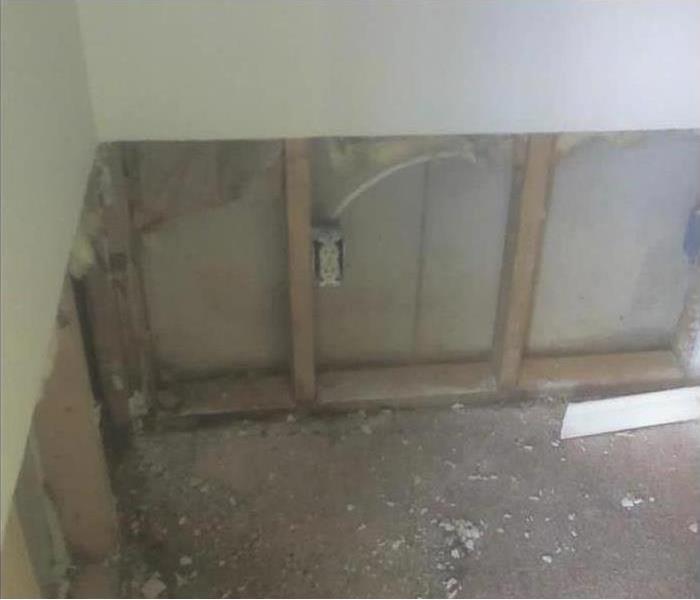 Mold may be part of life, but it doesn’t have to be an overwhelming problem
Mold may be part of life, but it doesn’t have to be an overwhelming problem
Keep Mold in the HVAC System at Bay
Whether a new, old, small, or large business, the people running it have plenty of things on their minds. When it comes to the structure the business operates out of, it can be easy to overlook what can’t be seen. One area of maintenance easily forgotten is HVAC cleaning—a surprising key to mold prevention.
While mold can easily be spotted on walls, floors and areas prone to water, it can also hide in air ducts. Below are three steps to help spot and deal with sneaky mold issues.
1. Inspect the HVAC system. Unfortunately, mold is something that pops up quickly and never completely goes away. Fortunately, it’s easy to minimize its growth by regularly checking around the system for moisture—mold fuel. Any signs of moisture around ducts, vents and the system’s parts, such as blowers, could indicate it’s time for an HVAC cleaning. Also, check that the drain and condensation pans are draining and not retaining water.
2. Get the system cleaned. Mold doesn’t only need moisture to make its rounds. It can also grow on dust inside the ducts and vents. Cleaning vents help reduce the accumulation of mold and keeps airflow operating smoothly. Business owners in Chester Springs, PA, with the potential for mold in their vents, should call an expert to help resolve the issue quickly and professionally.
3. Preventive maintenance keeps the mold away. Once an HVAC system is cleaned, it's time to set up a regular maintenance plan. Change filters regularly to stunt future growth, and ensure that the filters are positioned correctly. Continue to regularly inspect the system and its components for any moisture buildup or improperly functioning parts. Additionally, regular general dusting and vacuuming can help air ducts stay relatively clean, keeping mold from serious growth. Lastly, be sure to set up an annual cleaning appointment with an HVAC expert.
Mold may be part of life, but it doesn’t have to be an overwhelming problem. While HVAC cleaning may not be on the priority list, its benefits can help put business owners’ minds at ease.
FASTER TO ANY DISASTER
7/18/2022 (Permalink)
FASTER TO ANY DISASTER
Fire and water damages are never scheduled. Will you be prepared? Whether it's a burst pipe in an apartment complex or an electrical fire in an office building; SERVPRO is always ready. There's no such thing as a small emergency when it threatens the welfare of the tenants and the revenue of the property owner.
SERVPRO Franchise Professionals can manage the damage. With more than 1500 franchises in 48 states and over 40 years of business in the cleanup and restoration industry, you can rest easy knowing help is on the way. SERVPRO Professionals always keep thorough and detailed communication throughout the restoration process to help keep you informed and in control. SERVPRO's reputation has been built through experience and training in mitigation damages ranging from single-family homes to skyscrapers, and even the Pentagon!
Because emergency situations are never scheduled, SERVPRO implicates the 1-4-8 method of Service Response Guidelines to ensure efficient and timely services. The 1-4-8 Service Response Guideline method means that:
1- Within one hour from notice of loss, a SERVPRO Franchise Professional will contact you to arrange for service.
4- Within 4 hours of loss notification, a SERVPRO Franchise Professional will be on-site to start mitigation services (if necessary).
8- Within eight business hours of on-site arrival, a verbal briefing of the scope will be communicated to the appropriate person.
This response method helps to ensure that SERVPRO Professionals may help to avoid revenue loss for property owners and minimize inconvenience to tenants. Timely restoration services along with SERVPRO's Professional equipment and industry-approved techniques can help you resume normal business functions and may save you time and money. Available 24 hours a day, 365 days a year, SERVPRO Professionals will work hard to restore your property and your peace of mind.
The Fire is Just the "Starter"...
7/11/2022 (Permalink)
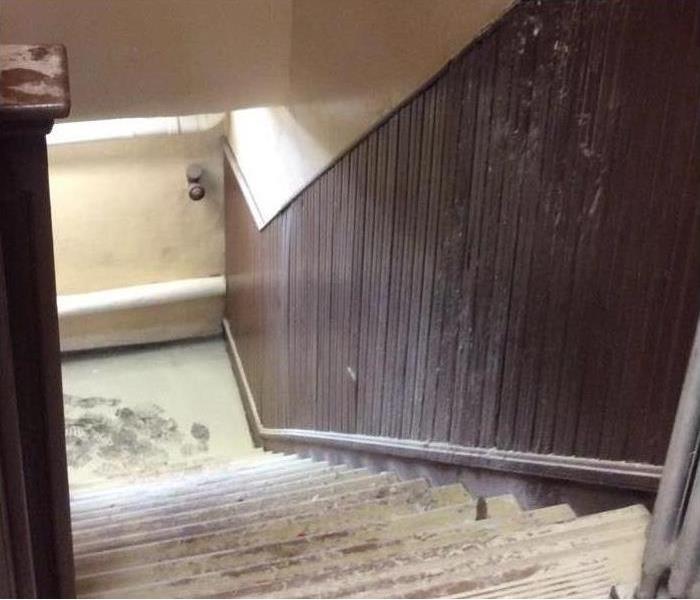 After a fire is extinguished, the process of restoration has just begun...
After a fire is extinguished, the process of restoration has just begun...
Fire damage is an unfortunate and significant event that comes in varying degrees. If you happen to experience a fire loss at your home or business, the extinguishing of the fire is just the start of a complicated process that we at SERVPRO of North East Chester County pride ourselves on being able to help you facilitate.
The Cleanup
Beyond the accumulation of soot and smoke damage, fire losses also usually accumulate significant amounts of debris and fire extinguisher discharge (if water is not used). These materials may be hazardous and are certainly unwanted and need to be appropriately removed and cleaned up after. Our technicians at SERVPRO of North East Chester County are ready to spring into action and handle the aftermath.
The Pack-Out
Oftentimes after a fire loss, some contents of a home or business must be inventoried, packed, cleaned off-site, and sometimes stored while the affected areas are cleaned and restored. At SERVPRO of North East Chester County, we are organized and thorough in our approach to making sure that your belongings are accounted for and restored, so once your home or business is ready to be loved in again, your belongings are returned "Like it never even happened."
You Cook...We Clean!!!
7/6/2022 (Permalink)
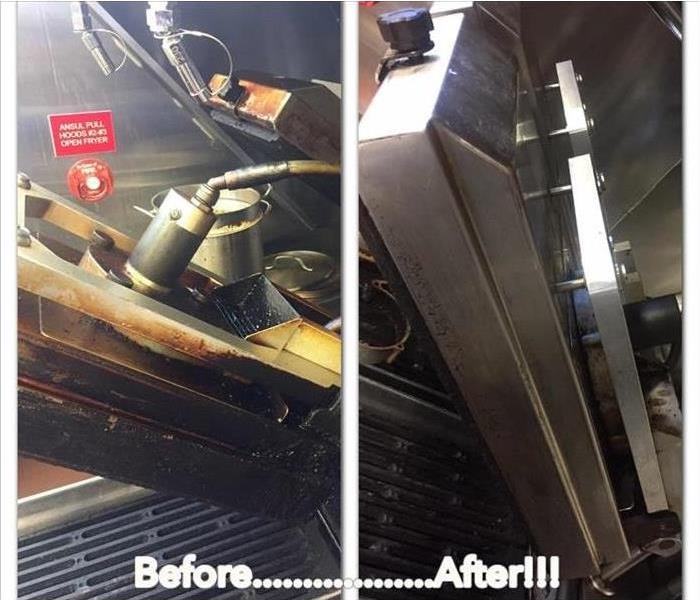 Goodbye Grease!
Goodbye Grease!
We clean while you cook!!!
Everyone loves a home-cooked meal or dining out with friends at a favorite restaurant, but who wants to clean up the kitchen???
SERVPRO of North East Chester County is ready and willing to provide professional, deep cleaning of your commercial or residential kitchen! Our skilled technicians have the equipment and the know-how to restore your kitchen - the heart of your home or business - to a pristine state that looks, smells, and feels clean.
RESIDENTIAL KITCHENS
Our technicians will hit all of those hard-to-reach spots that probably haven't been cleaned since the appliances first came off the truck. Your kitchen will feel and smell so fresh you will want to host the next family dinner or friends' dinner party to show off your newly restored space.
COMMERCIAL KITCHENS
Re-inspire your culinary staff with a professionally cleaned work space, and re-ignite their sense of pride and responsibility to maintain your restaurant kitchen. We take on the tough chores that you can never quite get to and can restore tired-looking, greasy equipment to a like-new luster!
3 Reasons Why You Need a Certified Water Damage Expert
6/27/2022 (Permalink)
There Are Three Reasons Why You Should Hire A Certified Water Damage Expert.
When you have a broken pipe in your business in Spring City, PA, and you know you need a water cleanup specialist, be sure they have the proper documentation from the Institute of Inspection, Cleaning, and Restoration Certification. Here are the top three reasons why this certification is important.
1. You Want Someone You Can Trust To Do the Job Right
The IICRC has certified more than 50,000 technicians and 6,500 firms worldwide. IICRC certifications provide credibility in the industry. They show that a technician has been trained and knows how to get the job done right. These facts should help build your confidence because you know that you are putting the restoration of your valuable property into the hands of a professional.
2. You Want Someone Who Knows Water Cleanup Methods
When it comes to water damage restoration, the IICRC offers certification as a Water Damage Restoration Technician. This certification shows that the technician understands water damage and knows how to perform remediation work. Study topics for this certification include effects, water losses, techniques, drying of structures, contamination, and sewer backflows. The WRT certification also serves as the prerequisite for the IICRC Commercial Drying Specialist, which is an advanced certification.
3. You Want Someone Who Knows How To Dry Commercial Structures
The CDS has demonstrated the ability to manage large drying operations for complex industrial, institutional, commercial, and residential buildings. These specialists are proficient in analyzing the anatomy of commercial properties and have improved inspection expertise and an advanced understanding of the drying process. It is not likely that you will find someone more suited to restoring your business as it was.
The IICRC certifies water cleanup professionals worldwide to provide you with the peace of mind that you will be getting your money’s worth when you hire a certified water damage expert.
The SERVPRO Emergency Response to Claims
6/21/2022 (Permalink)
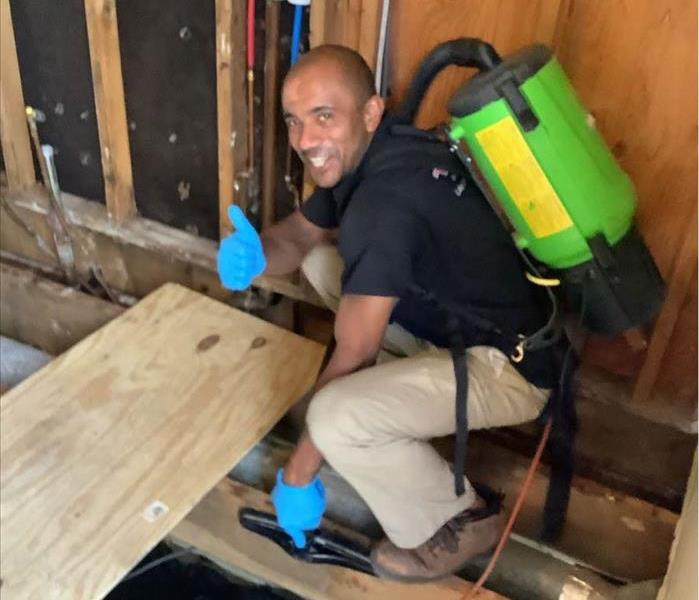 It may be a relatively minor incident or a devastating loss. No matter the extent of the damage, SERVPRO® is Faster to Any Size Disaster.
It may be a relatively minor incident or a devastating loss. No matter the extent of the damage, SERVPRO® is Faster to Any Size Disaster.
SERVPRO®'s Emergency Claims Response
Emergencies don't take place on a schedule. When your company experiences a disaster in South Pottstown, PA, you need help as soon as it occurs. Immediate repairs, protection against further damage, insurance claim services — it all has to happen fast.
Using the Emergency Response
A professional restoration service with agents available 24/7 can be your lifeline after you experience perils such as:
- Fire
- Tornado or storm damage
- Water damage from rain or flooding
- High winds
It may be a relatively minor incident or a devastating loss. No matter the extent of the damage, SERVPRO is Faster to Any Size Disaster. When you call, a technician is available to take your information at any time of day.
Staying Prepared
While you can't predict when a disaster will occur, you can prepare. The Emergency Ready Plan is designed to give you a strategy before a catastrophe happens.
Technicians conduct a no-cost assessment of your property. You complete a profile document that contains a concise list of critical information you need after an emergency. You benefit from a plan with:
- A chain of command to authorize work
- Facility details such as priority areas and shut-off locations
- Assistance with claim services
Getting Back to Work Quicker
After a disruption, you and your employees want things to return to normal as soon as possible. The Emergency Ready Plan helps you go through the restoration process quickly and smoothly. Avoiding downtime ensures you keep up your levels of productivity and gets everyone back to work “Like it never even happened”.
A disaster can strike your South Pottstown, PA, business at any time. That doesn't mean you have to be unprepared. A fast-acting remediation company helps you with cleanup, restoration, and claim services — every step of the way.
A Guide to the Three Types of Water Damage
6/16/2022 (Permalink)
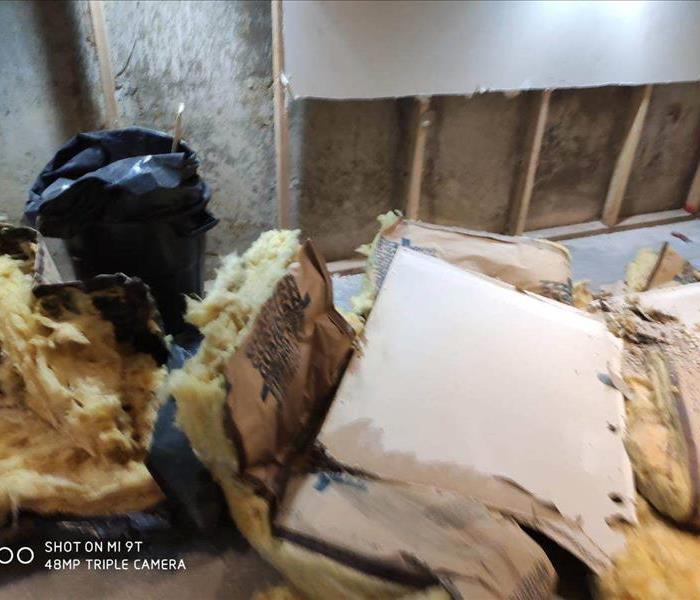 Knowing which category you are dealing with is important for the cleanup process.
Knowing which category you are dealing with is important for the cleanup process.
The Three Types of Water Damage
Water damage can occur due to several reasons. But no matter the cause, the water will be placed into one of three categories based on the level of contaminants present. This guide will break down the three categories of contaminated water and how to treat each type if your property in Phoenixville, PA, is impacted.
1. Category 1: Clean Water
As its name suggests, clean water is free of any contaminants and therefore not harmful upon exposure. This type of water damage can present itself wherever there is a clean water supply line, such as an overflowing sink or hose. If you experience Category 1 damage, blot up or remove as much of the water as you can and get the area to dry as quickly as possible to avoid mold growth.
2. Category 2: Gray Water
Contaminated water featuring chemical or biological elements is known as gray water. While this water carries microorganisms or bacteria, it is not as severely unsanitary as the final category. A sump pump failure or overflown toilet without fecal matter can be classified as gray water damage, as can water with chemical elements in it such as bleach or detergents. This type of damage is a bit more severe and requires extensive cleaning to prevent further harm.
3. Category 3: Black Water
The most unsanitary of all contaminated water, Category 3 damage contains high levels of bacteria, chemical toxins, and other hazardous properties. This largely presents itself in sewage backup and floodwater, though Category 2 water can develop into Category 3 if it sits stagnant for too long. If your property is infiltrated by this harmful water, immediately call a water damage cleanup company.
These pros are fully equipped to remove the unsanitary water and disinfect the impacted space.
Knowing which category you are dealing with is important for the cleanup process, and often the water source will indicate the level of contaminants present.
3 Types of Damage a Winter Storm May Cause
5/17/2022 (Permalink)
There Are Three Types Of Damage That A Winter Storm Can Cause.
When winter weather strikes South Pottstown, PA, the resulting icy blasts of below-zero temperatures, high winds and heavy snowfall can have a serious effect on your home. Inspecting your home after a winter storm can help you gauge any type of damage so you can take steps to have it repaired, keeping you and your family safe.
1. Roof Damage
Extreme winter weather can wreak havoc on your home, but few areas are as vulnerable as its roof. High winds can peel off shingles and damage flashing, leaving your attic vulnerable to animals and moisture. Heavy snow can also cause areas of the roof to buckle or droop. If you notice this or other problems after a powerful storm, you can cover the area with a tarp or secure your attic until you can get assistance.
2. Burst Pipes
When temperatures drop below freezing during a blizzard, your home's pipes could expand as water freezes inside them. After several days of frigid weather, outdoor and indoor wall pipes may burst, causing flooding in and around your home. Water damage can cause mold growth and warping of wood flooring and furniture, but insulating your pipes by wrapping them in fabric or insulated foam can prevent this from happening.
3. Ice Dams
Periods of freezing and thawing can cause your home's gutters to malfunction during a winter storm. Clogged or slow-draining gutters may form ice dams, causing water to back up into your home and leave behind considerable water damage to your ceilings and walls. A storm damage and restoration service can assist by clearing and repairing your gutters to ensure they drain properly.
When a winter storm howls through South Pottstown, PA, the resulting damage to your home could be considerable. Knowing what to look for and when to call for assistance for repairs can keep your home and family safe, no matter the weather.
Commercial Storm Preparation
5/8/2022 (Permalink)
Storm Preparation For Businesses
Many business owners in Spring City, PA, are inadequately prepared for a major rain storm event. Do you know how to protect your assets and employees in the event of a serious flood damage situation?
1. Site Assessment
One of the simplest things you can do to prepare your company for severe weather is to inspect the site. Ensure that the foundation has no major points of fluid entry and that the roof and gutters direct rainfall away from the base of all buildings. Trim any trees with dead branches, as these can become an airborne hazard during high winds. Most larger buildings will need a lightning rod, which must be maintained and properly grounded. If your site has windows that require storm shutters, draw them at the first sign of trouble.
2. Training and Readiness
Don't forget the human element. Since your employees are your most valuable asset, you must supply your workforce with sufficient information about how to respond to a severe rain storm. For tornadoes, designate an interior hallway on the ground floor as a temporary shelter. For hurricanes and other long-term hazards, ensure that your staff comply with local evacuation orders and other pertinent ordinances. If you keep normal working hours during a potential weather event, stay aware of outdoor conditions through a NOAA radio broadcast or website.
3. Other Considerations
Your insurer can assist you with a business continuance plan should a thunderstorm make normal operations impossible. Retain paper copies and digital backups of all policies, records, and tax information. If you anticipate filing a claim, contact your adjuster as soon as possible. You will also likely need a qualified professional service to help with flood cleanup.
You can't prevent a rain storm, but you can keep it from disrupting day to day activities at your workplace. Safeguard your employees and your inventory by preparing for every type of severe weather.
How Business Interruption Insurance Can Help After a Fire
5/2/2022 (Permalink)
How Business Interruption Insurance Can Assist Following A Fire
A fire can devastate your business in Phoenixville, PA, can displace you and your employees. However, having a contingency plan that includes an insurance policy with a business interruption rider can help you continue working. In addition, your policy may help you pay for various expenses, including the following when a business fire forces you out of your space.
Relocation Expenses
After a fire, you may need to evacuate your space while a fire cleaning crew assesses and repairs the damage. Your clients and vendors may expect business as usual, and insurance can help you pay to move your operations to a temporary location equipped with everything you need to run your business, including:
- Phones, scanners and computers
- Desks, chairs and other furnishings
- Utilities and other services
Rent and Mortgage Payments
Although you and your team may operate from a different location, you must still pay the rent or mortgage on your fire-damaged space. Business interruption insurance can help you pay to maintain both, while a fire cleaning service ensures you can return to your original business home.
Lost Income
A business fire can damage the inventory you plan to sell, leading to significant income losses. Your insurance representatives can review your profits from prior months and recommend reimbursement for profits that you will not receive due to the damage to your inventory.
Payroll
After a fire, you will likely need all hands on deck to ensure you can meet your operational needs. However, if your income drops significantly, you may struggle to meet your payroll obligations. Fortunately, you can maintain your entire staff when you rely on insurance to cover your staff's wages.
Training
You may need to train your staff to operate new equipment, perform new tasks or learn other procedures following a business fire. Again, insurance can help relieve the financial burden accompanying training your staff.
A disaster at your business in Phoenixville, PA, does not need to shut down your operation when you have business interruption insurance to help you with your expenses.
When Does Mold Growth Follow Flooding?
4/16/2022 (Permalink)
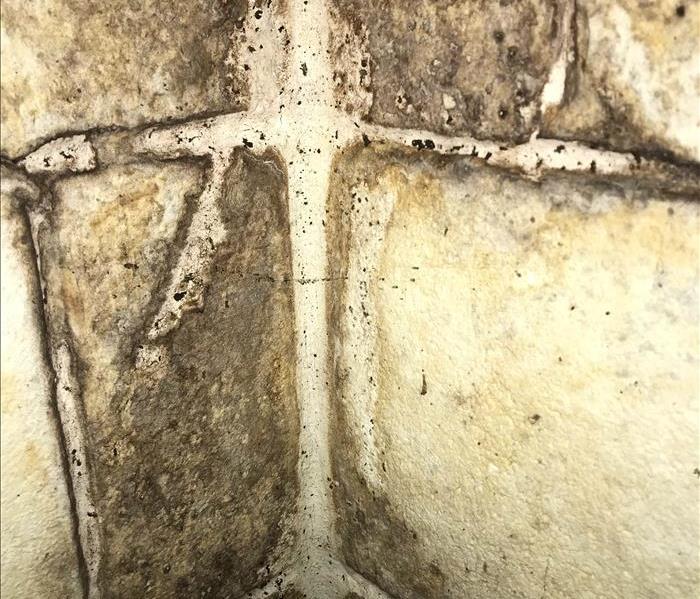 The most important mitigation measures should be taken within the first 24 to 48 hours after flooding occurs.
The most important mitigation measures should be taken within the first 24 to 48 hours after flooding occurs.
When Does Mold Start To Grow After Flooding?
If flooding has recently affected your home in South Pottstown, PA, you are likely to be concerned about the effects of water damage and mold growth. Fungus may develop within just 24 to 48 hours of primary damage. Restoration experts classify flood water as highly contaminated Category Three Water because it may contain solid waste in addition to bacteria, chemicals, and other dangerous debris. Learn more about mitigation measures to limit primary storm or water damage and prevent mold.
The First Two Days
The most important mitigation measures should be taken within the first 24 to 48 hours after flooding occurs. If you have remained at home during a flood, contact a mitigation and restoration service as soon as possible. If you have evacuated, schedule a consultation immediately after returning to a damaged residence. It is ideal to have trained professionals take the following steps within the first two days:
- Assess damage
- Extract standing water
- Tear out damaged materials
- Clean and disinfect
These measures can limit primary damage and discourage mold growth. Porous materials such as carpet, drywall, and insulation are difficult to disinfect and may pose an elevated mold risk. These materials should be torn out and the affected area cleaned, disinfected, and permitted to dry before restoration.
The Week After Flooding
In the event of an evacuation, damage may be left standing for longer than 24 to 48 hours. It is important to take the measures listed above as soon as possible to limit damage. Over the next few days, the affected area should be dried. Storm damage mitigation professionals may recommend using air movers, fans, or dehumidifiers.
Ideally, mitigation will commence within 24 to 48 hours of water damage. It is crucial to remove standing water as quickly as possible. Maintaining low residual moisture levels afterward can prevent mold growth at a residence in South Pottstown, PA.
3 Ways To Eliminate Odors After a Flood
4/1/2022 (Permalink)
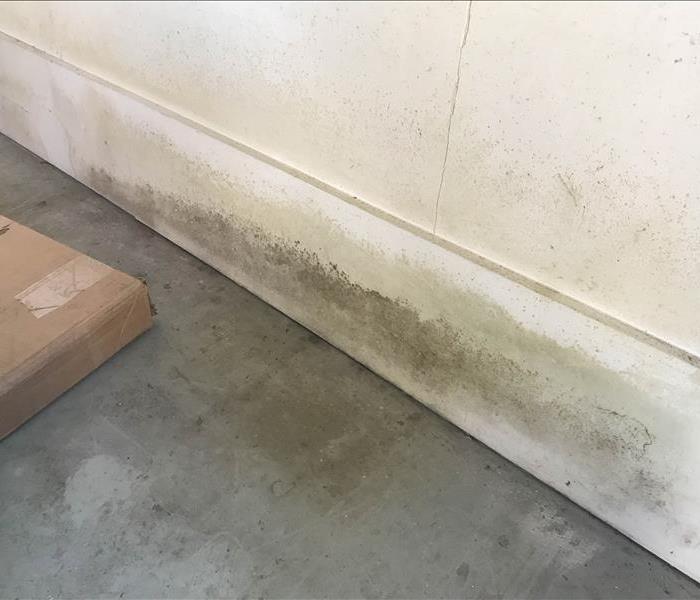 After standing water has been extracted from a residence, it is important to clean and disinfect the area that was flooded.
After standing water has been extracted from a residence, it is important to clean and disinfect the area that was flooded.
After A Flood, Here Are 3 Ways To Get Rid Of Odors.
Flood water is highly contaminated and can cause undesirable odors to linger at a residence in Phoenixville, PA. Secondary damage, such as mold growth, can intensify a musty smell and cause odors to return even after remediation treatments. Here are three ways to get rid of flood-related odors.
1. Clean and Disinfect the Affected Area
After standing water has been extracted from a residence, it is important to clean and disinfect the area that was flooded. Porous building materials and contents should be considered sewage loss and disposed of, as these materials are difficult to disinfect and may support the growth of odor-causing bacteria or mold. Removing every trace of flood residue is the first step toward banishing undesirable odors.
2. Make Sure Mold Is Not Growing
Homeowners can discourage mold growth by running a dehumidifier to maintain indoor relative humidity levels between 30 percent and 50 percent. The telltale musty odor associated with mold is caused by microbial volatile organic compounds released as off-gases during the growth cycle. If this odor is detectable after a flooded residence has been cleaned, disinfected, and dried, a homeowner should arrange for professional mold testing.
3. Use Odor Remediation Methods
If no indications of active fungus growth are detected, a homeowner can pursue odor remediation. Damage restoration experts may recommend the use of a HEPA air scrubber to filter out odor-causing particles followed by specialized neutralization treatments such as ozone or hydroxyl generation, thermal fogging, or vapor modification.
It is necessary to mitigate primary storm or flood water damage and ensure that secondary damage is not present before attempting to eliminate odors. If mold growth is present, odor remediation will not have the desired effect and will only temporarily mask indications of a larger problem. For the best results, homeowners should rely on an all-in-one mitigation and restoration service located in Phoenixville, PA.
3 Main Causes of Leaky Faucets
4/1/2022 (Permalink)
The 3 Most Common Causes Of Leaky Faucets
Did you know that a leaking faucet can waste a swimming pool’s worth of water every year if not repaired? This adds up to about 10,000 gallons of water per leak. If your house in Kimberton, PA has a drip that just won’t quit, you can fix it yourself if you know the basics. Read on to discover the principal causes of leaky faucets and what to look for when repairing them.
1. Faulty Washer
A washer is a thin metal or plastic disc with a hole in the middle that functions as a spacer or to distribute load in compression-style faucets (those with separate handles for hot and cold). Whenever you turn the dripping faucet on or off, it subjects the washer to friction that wears it down. Take the old washer to a hardware store to find the correct replacement part and install it in the faucet. Incorrectly placed washers can also cause leaks, so if the leak continues, try adjusting it.
2. Damaged O-Ring
Cartridge faucets use a single valve to control the flow and temperature of water, and contain rubber o-rings that form a seal near the handle or spout. (This style of faucet often has a decorative cap on the handle if you’re unsure what kind you have.) Find the o-ring inside your leaking faucet and replace it with a new one.
3. Worn Valve Seat
The valve seat is another component of a compression faucet and is the connection between the spout and the faucet. Over time, minerals in the water eat away at the valve seat, causing it to corrode. This happens faster if you have hard water, and will probably be apparent upon inspection of the part. Cleaning or replacing the valve seat should enable you to have a fixed leak.
If left alone, a leaking faucet can cause more extensive damage that requires the help of emergency restoration services. Save yourself unnecessary stress and expense by fixing those drips as soon as you discover them.
Do Renters Insurance Policies Cover Fire Damage?
3/21/2022 (Permalink)
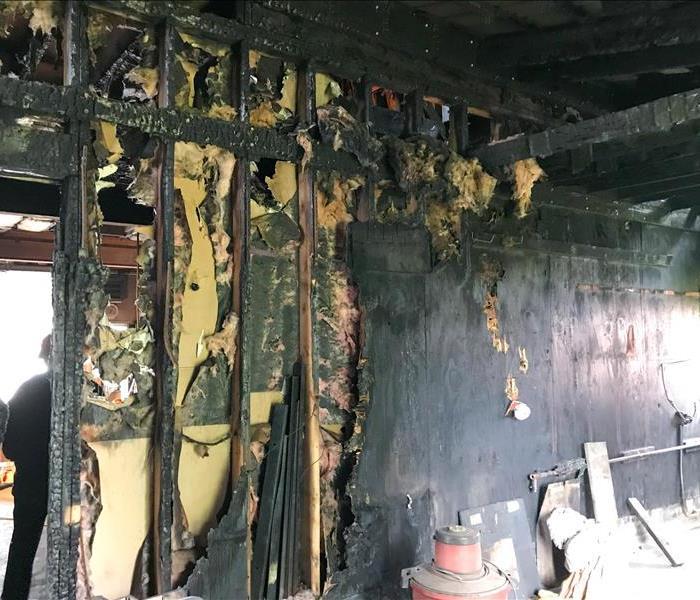 A tenant should assess the terms of a policy before he or she needs to file a fire damage claim for the contents of an apartment.
A tenant should assess the terms of a policy before he or she needs to file a fire damage claim for the contents of an apartment.
Is Fire Damage Covered By Renters Insurance?
Renters insurance can cover damage to a tenant's property after a fire at an apartment or rental house in South Pottstown, PA. Structural damage should be covered by the property owner's insurance policy. Find out more about what rental policies do and do not cover, and how to file a claim.
What Is Covered
A renters policy provides coverage for the contents of an apartment or rental home. This includes items such as:
- Clothing
- Furniture
- Electronics
- Personal effects
Renters should select policies that cover replacement costs rather than actual cash value. This policy may also include limited amounts of loss of use and liability coverage. The latter can be helpful in the event that a third party sustains an injury on or near the property due to the fire.
What Is Not Covered
Renters insurance does not cover structural damage. The owner or landlord will need to file a separate property insurance claim for:
- Building materials
- Included contents
- Fire Restoration
The process of filing a claim calls for documenting damage, a visit from an adjuster, and filing proof of loss. It is the owner's responsibility to clean up fire damage or hire a mitigation and restoration service.
Filing a Claim
A tenant should contact their insurance provider as soon as possible after a fire. The policyholder can also take several measures to support their claim, including:
- Documenting damage
- Gathering receipts
- Listing damaged contents
A renter may want to contact a restoration company to determine whether certain items can be cleaned or repaired rather than replaced. The policyholder can obtain an estimate and submit this information to the insurer.
It is important to know precisely what a renters insurance policy covers. A tenant should assess the terms of a policy before he or she needs to file a fire damage claim for the contents of an apartment or house in South Pottstown, PA.
3 Steps To Handling Water Dripping From Your Light Fixtures
3/14/2022 (Permalink)
Three Steps To Dealing With Water Dripping From Light Fixtures
Though you might assume any major water leaks you’d come across in your Charlestown, PA, home would materialize from something like a faulty toilet or a leaky faucet, finding dripping water in your light fixtures is actually a common occurrence. If you’re new to the problem, however, it can be hard to determine where to start in dealing with the water leak and possible ceiling damage. Here are three crucial steps to take if you find yourself needing to stop the spread of water leaking through your fixtures.
1. Turn off the electricity to your home through the breaker box. While merely shutting off the light switch of the affected light might seem like the best idea, this can be dangerous and should be avoided. After all, any contact with the electrical current from the fixture and the source of water can cause electric shock, so going straight to the breaker box is vital to staying safe.
2. Shut off the water supply to stop any leaks. While the electricity is off, it’s also important to contain the spread of water by shutting off the main water valve to your home. Depending on where the water in the light fixture is coming from, leaving the water running can create more ceiling damage or extensive problem areas inside your walls.
3. Contact a qualified restoration crew to address the situation. Once you’ve properly contained the area as safely as you can, it’s best to let experienced water damage restoration technicians handle the cleanup. After the source of the leak has been repaired and the resulting damage assessed and restored, an electrician can then suitably fix your affected light fixtures, as well.
Be Prepared for Even the Oddest of Water Leaks
While finding water in a light fixture can be a strange sight to see in your Charlestown, PA, home, it’s no less dangerous or damaging to your home than any other water leak on the property. For this reason, it’s crucial to act quickly and call upon others to help you restore your home before any more damage occurs.
Cleaning Water From a Wood Floor Helps Prevent Major Damage
3/8/2022 (Permalink)
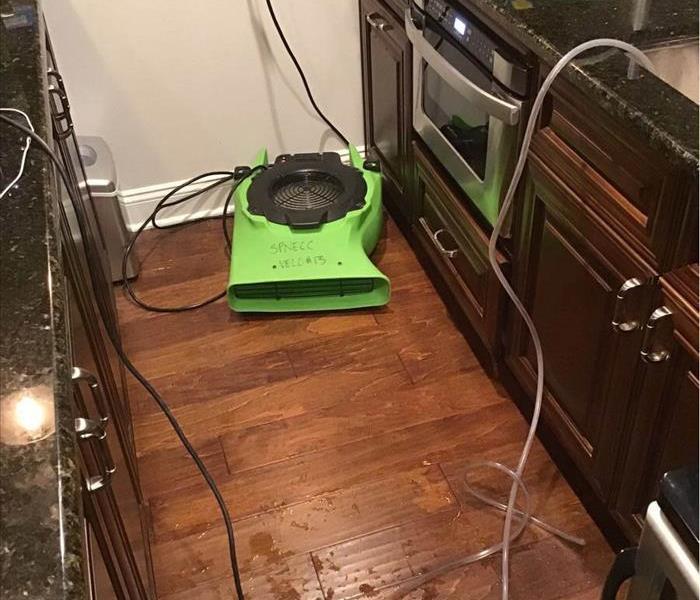 Sometimes our team can save hardwood floors and sometimes they need to be removed and replaced. Call us before it's too late.
Sometimes our team can save hardwood floors and sometimes they need to be removed and replaced. Call us before it's too late.
Cleaning Water From A Wood Floor Aids in the Prevention of Major Damage
Water and wooden floors in your Charlestown, PA, building don't mix well. After a leak, pipe burst or flooding in your facility, it doesn't take long for damage to set in on your hardwood flooring. It's critical to clean up the water as soon as possible to avoid replacing the wood.
Cleanup Equipment
To get started cleaning up a wet floor, you'll need:
- Shop vacuum
- Brush with stiff bristles
- Squeegee
- Absorbent cloth
- Rubber gloves
- Bucket
- Mild detergent
Removing the Water
Time is of the essence when cleaning up a wood floor. Fibers in the wood will begin to absorb moisture quickly but release it slowly. Begin by using the shop vacuum and squeegee to draw out as much water as possible. Scrub the floor with detergent and a stiff brush to remove as much dirt and mud as you can. This process will help prevent mold growth, as mold thrives in moisture and feeds on organic material in the dirt. If the flood or pipe burst has already caused mold growth, a restoration company can mitigate damage.
Drying the Floor
Begin the drying process by increasing airflow. Open doors and windows and use fans to move fresh air throughout the space. Try putting a fan in a window or open door, then opening doors or windows on the opposite side of the room. This creates cross-ventilation to move moisture out of the area.
It's essential to dry the wet floor slowly and avoid applying heat. Wood that dries too quickly or is exposed to a heater can crack or split.
Refinishing the Floor
If your wood floor has minor warped or cupped areas, you can use a drum sander to repair them. Boards with heavy damage will need replacing. If floorboards are lifted at the ends, you can face-nail them back in place.
Cleaning up quickly after a pipe burst or flood in your Charlestown, PA, facility can help you avoid major issues down the road.
What To Do if You Smell a Musty Odor From Your AC
3/3/2022 (Permalink)
What Should You Do If You Notice A Musty Odor Coming From Your Air Conditioner?
As a commercial property owner or manager in East-West Pikeland, PA, you know there are many tasks you must perform to keep buildings running smoothly. If you’ve ever noticed a musty odor when you run the heating or air conditioning, it might be time to check the ducts for black mold. An understanding of the signs, and how to prevent mold in the future, will help you identify the problem. Here are a few things to look for.
Signs of Mold
Even though it is small, mold leaves signs that will alert you to its presence. When determining the source of a musty odor, the first thing you should do is check for the telltale symptoms of mold:
Black dust near air ducts
Moisture or discoloration on floors or walls
Foul odors when air is flowing
If you notice any of these signs, the best thing to do is call a mold remediation specialist. Cleaning and sanitizing mold-affected items requires specialized equipment and expertise, so this is not a DIY situation. If you try to clean it on your own, you'll likely make the problem worse.
Prevent Mold
After your building is free of black mold, you’ll want to prevent it from coming back. Here are a few simple things you can do:
- Improve ventilation
- Keep gutters clean
- Change the HVAC air filter regularly
- Install a humidity sensor
- Inspect bathrooms and kitchens for water leaks
These tasks will help you keep your building free of excess moisture, which causes mold growth. Depending on your climate, you may want to consider a system-wide dehumidifier to keep levels under control. In addition, you can schedule an annual duct cleaning to ensure mold doesn’t grow unnoticed.
Black mold is a tiny organism that can create significant problems if not addressed in a timely manner. By ensuring your building has clean ducts, you’ll maintain a good space for everyone inside.
How To Create a Business Continuity Plan
2/1/2022 (Permalink)
What Is a Business Continuity Plan and How Do I Make One?
A continuity plan can help business owners cope with storm damage or flooding at a commercial structure in Phoenixville, PA. Owners should take the following measures to limit lost revenue due to unexpected setbacks.
Perform a Business Impact Analysis
Any successful plan for continued operation after a storm or disaster calls for accurate operational data. Business owners should make several calculations:
- Average expenses and revenues
- Risk assessments for floods, storms and other types of damage
- Scenarios that could interrupt business
- The effects of supply shortages or service delays
This analysis can help owners make more informed choices with regard to property insurance policies and interruption riders. A gap analysis is another important component of a complete impact analysis.
Come Up With Continuity Options
Once a business owner has assessed the situation of a business and identified potential problems, the next step is to come up with solutions. A continuity plan may include measures to lower the total of an interruption claim or avoid the necessity of using this coverage:
- Reducing continued costs during closure
- Moving to a temporary location
- Operating out of an undamaged portion of the primary location
If specialized equipment or other issues prevent a business from operating, it is a good idea to file an interruption claim. This commercial policy rider can offset continued expenses such as rent or payroll until a business reopens. Business owners may want to refer to federal guidelines when developing a plan.
Delegate Responsibilities
A plan cannot succeed without trained staff. Business owners should delegate responsibilities and complete training in advance of an interruption. Maintain open lines of communication in the event of a disaster.
These are the major stages of developing and implementing a continuity plan. If a business sustains storm damage or suffers from flooding in Phoenixville, PA, owners should rely on the expertise of damage mitigation and restoration professionals.
The Top 4 Recommended Locations for Fire Alarms in Your Home
2/1/2022 (Permalink)
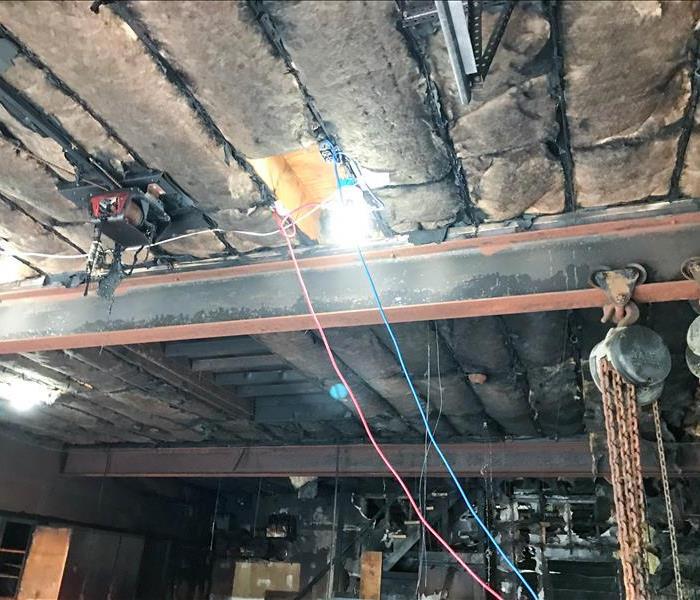 It doesn’t take long for a house fire to quickly get out of hand!
It doesn’t take long for a house fire to quickly get out of hand!
The Top 4 Places In Your Home Where Fire Alarms Should Be Installed
While you might assume that when you bought your home in Chester Springs, PA, it came already installed with all the smoke alarms you need to keep your family safe, this is not always the case. As more research has been conducted over the years on fires and how they spread, requirements have changed. Many older homes do not meet these standards which can be dangerous in the case a fire does occur. Keep your family safe by ensuring a fire alarm is located in the following four locations!
1. Bedrooms
The National Fire Protection Association suggests the placement of a fire alarm in every bedroom of the house. This ensures that if a fire occurs while your family is asleep, the alarms will wake quickly wake up everyone.
2. Outside Every Sleeping Area
Not only should alarms be inside every bedroom, there should be a smoke alarm right outside the room or any other sleeping areas as well. This is so you can react and start to escape before any fire or smoke even enters your room.
3. 10 Feet From Your Kitchen
Kitchen fires result in approximately 50 percent of all home fires, many of which result in serious fire damage to your home. Make sure a fire alarm is located 10 feet from your kitchen rather than inside it since smoke or steam from cooking can easily trigger it.
4. Every Level of Your Home
Ensure that there is as least one smoke alarm on every level of your home. Don’t forget your basement! Serious fire and smoke damage can occur from an undetected fire that starts in the basement.
It doesn’t take long for a house fire to quickly get out of hand! That’s why it is so important to have all the required fire alarms installed so you can quickly get everyone out of your house and get in contact with the fire department and a fire restoration company to minimize the fire damage to your home.
Mold and Evaporative Cooling
1/6/2022 (Permalink)
Evaporative Cooling And Mold
Residents in Phoenixville, PA, want to stay cool in the summer months. However, your home cooling systems can harbor hidden fungal agents if not properly maintained. Read on to learn how to address a leaking swamp cooler and other pressing problems.
1. About the Appliance
A swamp cooler is an air cooling system designed for climates with consistently low humidity during the summer. Because the saturation of water in the air is so low in these arid climates, it is easy for water molecules to evaporate, removing heat energy from the air during the transition. Most swamp coolers have a fan that blows air over a porous cellulose pad. This air is circulated through the house in a similar manner to conventional compressor-based air conditioners.
2. Mold Conditions
Unfortunately, because these swamp cooler units operate in warm climates and introduce moisture, they are potential sites for mold growth. This phenomenon is exacerbated by the dark conditions inside the unit and the air ducts, since direct sunlight tends to suppress mold. Other mold issues can arise due to a leaking swamp cooler, since any water that spreads beyond the direct path of the fan can build up without evaporating. This also encourages mold to grow.
3. Remedies
If mold is in direct contact with the cellulose pad, simply purchase a replacement for your make and model of evaporative cooler. Acquire a HEPA filter for your home and ensure adequate air circulation until you can be sure that any particle contaminants are clear. If the unit leaked water into surrounding construction materials such as drywall or flooring, contact a qualified mold damage restoration service.
Remember, while the energy savings of an evaporative cooling system are substantial, they also come with certain risks. Prevent a leaking swamp cooler from becoming a major mold problem by maintaining your unit.
Fire Insurance: Why It’s Important
1/5/2022 (Permalink)
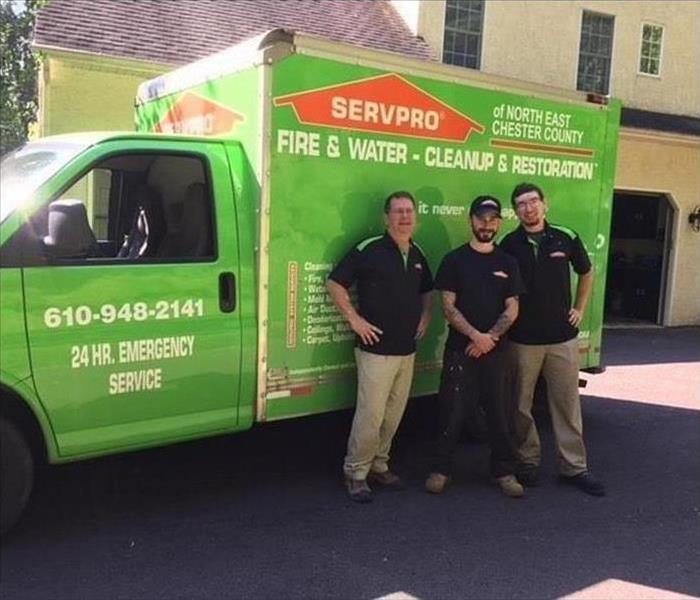 SERVPRO is here to help in your time of need. We are fire damage restoration experts who are available 24 hours a day to respond when you need us.
SERVPRO is here to help in your time of need. We are fire damage restoration experts who are available 24 hours a day to respond when you need us.
Why Do You Need Fire Insurance?
Fire insurance is essential, especially for commercial and industrial properties. While this type of insurer is excellent in the event of a fire, it is also important to note the significant coverages of most of these insurance policies.
1. Fire Damage
The most obvious coverage is for fire damage. While it is true that some business policies will cover certain losses, it is important to note that policies specific to fire disasters will likely cover all aspects of fire damage with minimal pushback from your insurer.
2. Suppression Systems and Tools
Additionally, fire insurance will likely cover any necessary maintenance expenses of your fire suppression system and equipment. This means that if an annual inspection uncovers some serious issues with your sprinkler system, then your policy will likely cover the cost of repairs.
3. Utility Repair
If a fire occurs, and not only the structure of your property is damaged, but also the utilities running throughout your facility are as well, then a fire policy will likely cover the costs of repair. This goes for damaged plumbing, electrical, gas lines and even ductwork. The coverage should also extend to duct cleaning as well, ensuring that harmful chemicals from the smoke and fumes are cleared of your HVAC system.
4. Mitigation and Restoration
Lastly, insurance geared toward fire disasters may even cover the costs associated with fire restoration. Your insurer and a disaster restoration specialist in the Phoenixville, PA, area can shed more light on the specifics of this type of coverage. However, these specialists are experts in the areas of fire and smoke cleanup which is what your policy was created for.
Fire insurance as a stand-alone policy or an addendum to your current business policy is a wise decision for your commercial property. These policies provide security in the event of significant property loss due to fires, which are more common in commercial real estate than residential properties.
How to Tell if You Must Replace My Carpet After a Flood?
1/5/2022 (Permalink)
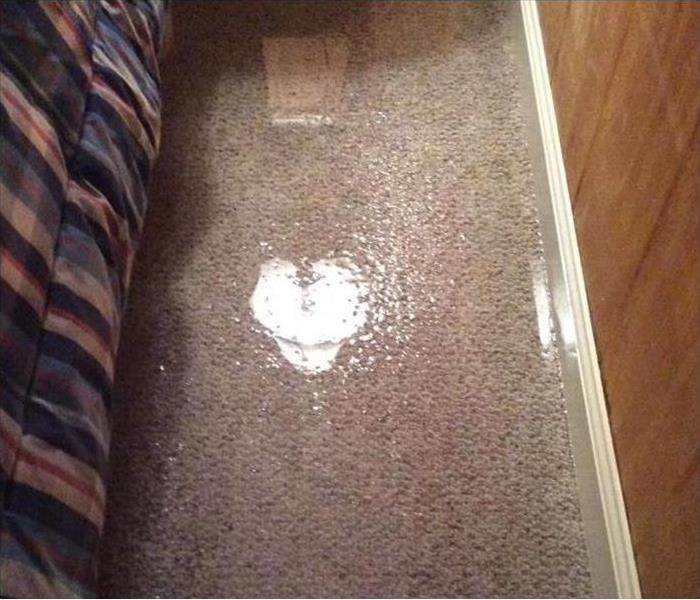 Is water damage present in your home? Call SERVPRO for all your restoration needs. Our crew is always available for you!
Is water damage present in your home? Call SERVPRO for all your restoration needs. Our crew is always available for you!
How Can I Tell If My Carpet Needs to Be Replaced After a Flood?
Water damage can come in various levels of severity and size—from a pipe break dribbling water into a wall, to excess rain flooding an entire basement. Regardless of the issue, you may have to repair or replace parts of your home. If you’re not sure whether the floorings needs attention, pay attention to warning sides that it’s time to tear out your carpet and lay down something new.
The Solutions
If water finds its way onto your floor, you have a few options to remedy the situation. Minor issues require a quick fix, while more widespread flooding will deem a complete replacement. Here the possibilities when a pipe break or other water problems damage your flooring:
- Hand-dry the floor with towels.
- Dry the floor with towels and blow-dryer.
- Clean the carpets with professional-grade machines.
- Replace the carpets.
When to Replace: Black Water
Raw sewage flooding is perhaps the worst type of flood you can experience in your Spring City, PA, home. A sewer backup or major toilet leakage could send dangerous microscopic pathogens into your home. Known as black water because it contains human feces, this flood water can harm or even kill you. This will require complete restoration.
When to Replace: You Didn’t Immediately Discover the Water
If you can detect a leak or other water issues quickly, you can often salvage carpet, drywall or other parts of your home. However, if the flooding starts while you’re not at home, and water sits on the floor for days or even hours, you probably won’t be able to save the flooring. There will be too much saturation, and you should call a professional cleanup company to tear out the carpets.
There’s no reason to take chances when it comes to a pipe break and significant flooding in your house. If black water or standing water infiltrates your carpet, plan on letting a professional replace it.




 24/7 Emergency Service
24/7 Emergency Service















